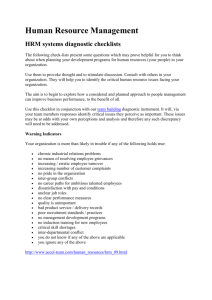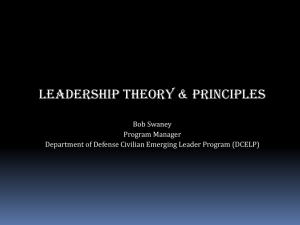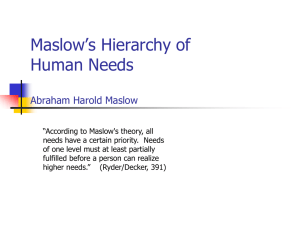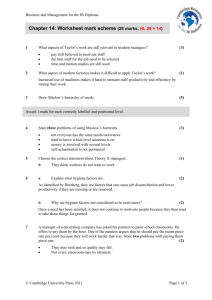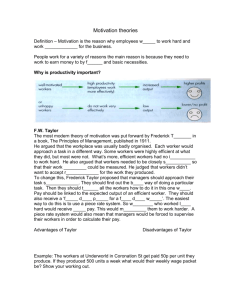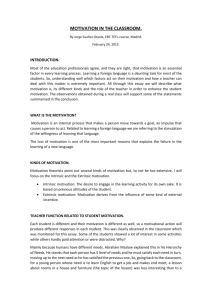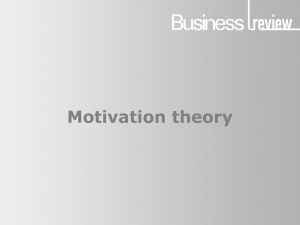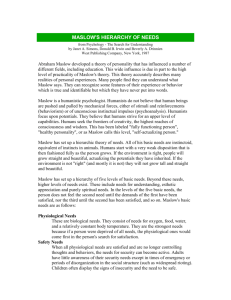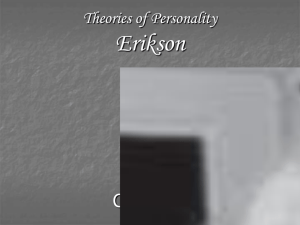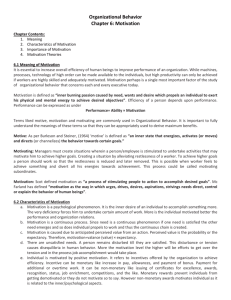An Overview of Motivation Theories
advertisement
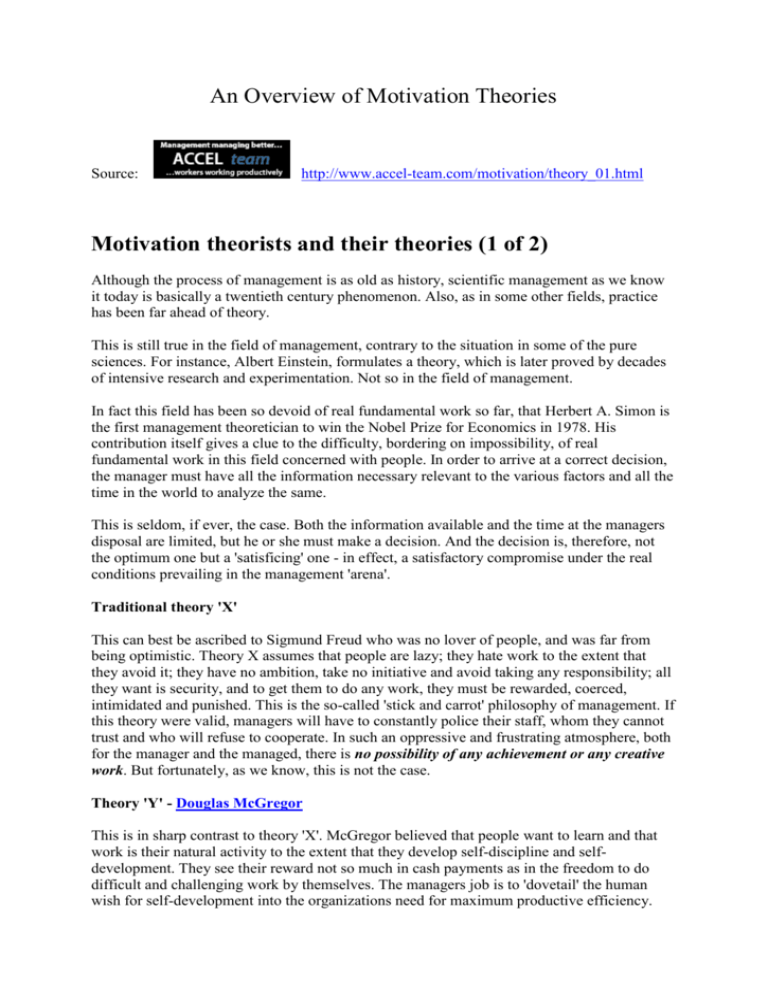
An Overview of Motivation Theories Source: http://www.accel-team.com/motivation/theory_01.html Motivation theorists and their theories (1 of 2) Although the process of management is as old as history, scientific management as we know it today is basically a twentieth century phenomenon. Also, as in some other fields, practice has been far ahead of theory. This is still true in the field of management, contrary to the situation in some of the pure sciences. For instance, Albert Einstein, formulates a theory, which is later proved by decades of intensive research and experimentation. Not so in the field of management. In fact this field has been so devoid of real fundamental work so far, that Herbert A. Simon is the first management theoretician to win the Nobel Prize for Economics in 1978. His contribution itself gives a clue to the difficulty, bordering on impossibility, of real fundamental work in this field concerned with people. In order to arrive at a correct decision, the manager must have all the information necessary relevant to the various factors and all the time in the world to analyze the same. This is seldom, if ever, the case. Both the information available and the time at the managers disposal are limited, but he or she must make a decision. And the decision is, therefore, not the optimum one but a 'satisficing' one - in effect, a satisfactory compromise under the real conditions prevailing in the management 'arena'. Traditional theory 'X' This can best be ascribed to Sigmund Freud who was no lover of people, and was far from being optimistic. Theory X assumes that people are lazy; they hate work to the extent that they avoid it; they have no ambition, take no initiative and avoid taking any responsibility; all they want is security, and to get them to do any work, they must be rewarded, coerced, intimidated and punished. This is the so-called 'stick and carrot' philosophy of management. If this theory were valid, managers will have to constantly police their staff, whom they cannot trust and who will refuse to cooperate. In such an oppressive and frustrating atmosphere, both for the manager and the managed, there is no possibility of any achievement or any creative work. But fortunately, as we know, this is not the case. Theory 'Y' - Douglas McGregor This is in sharp contrast to theory 'X'. McGregor believed that people want to learn and that work is their natural activity to the extent that they develop self-discipline and selfdevelopment. They see their reward not so much in cash payments as in the freedom to do difficult and challenging work by themselves. The managers job is to 'dovetail' the human wish for self-development into the organizations need for maximum productive efficiency. The basic objectives of both are therefore met and with imagination and sincerity, the enormous potential can be tapped. Does it sound too good to be true? It could be construed, by some, that Theory 'Y' management is soft and slack. This is not true and the proof is in the 'pudding', for it has already proved its worth in the USA and elsewhere. For best results, the persons must be carefully selected to form a homogeneous group. A good leader of such a group may conveniently 'absent' from group meetings so they can discuss the matters freely and help select and 'groom' a new leader. The leader does no longer hanker after power, lets people develop freely, and may even (it is hoped) enjoy watching the development and actualization of people, as if, by themselves. Everyone, and most of all the organization, gains as a result. Theory 'Z' - Abraham Maslow This is a refreshing change from the theory X of Freud, by a fellow psychologist, Abraham Maslow. Maslow totally rejects the dark and dingy Freudian basement and takes us out into the fresh, open, sunny and cheerful atmosphere. He is the main founder of the humanistic school or the third force which holds that all the good qualities are inherent in people, at least, at birth, although later they are gradually lost. Maslow's central theme revolves around the meaning and significance of human work and seems to epitomize Voltaire's observation in Candide, 'work banishes the three great evils boredom, vice and poverty'. The great sage Yajnavalkya explains in the Brihadaranyaka Upanishad that by good works a man becomes holy, by evil works evil. A mans personality is the sum total of his works and that only his works survive a man at death. This is perhaps the essence of Maslow's hierarchy of needs theory, as it is more commonly know. Maslow's major works include the standard textbook (in collaboration with Mittlemann), Principles of Abnormal Psychology (1941), a seminal paper, 'A Theory of Human Motivation' (1943) and the book, Eupsychian Management (pronounced yew-sigh-keyan) published in 1965. Maslow's theory of human motivation is, in fact, the basis of McGregor's theory 'Y' briefly described above. The basic human needs, according to Maslow, are: physiological needs (Lowest) safety needs; love needs; esteem needs; and self-actualization needs (Highest) Mans behavior is seen as dominated by his unsatisfied needs and he is a 'perpetually wanting animal', for when one need is satisfied he aspires for the next higher one. This is, therefore, seen as an ongoing activity, in which the man is totally absorbed in order to attain perfection through self-development. The highest state of self-actualization is characterized by integrity, responsibility, magnanimity, simplicity and naturalness. Self-actualizers focus on problems external to themselves. His prescription for human salvation is simple, but not easy: 'Hard work and total commitment to doing well the job that fate or personal destiny calls you to do, or any important job that "calls for" doing'. Maslow has had his share of critics, but he has been able to achieve a refreshing synthesis of divergent and influential philosophies of: Marx - economic and physical needs; Freud - physical and love needs; Adler - esteem needs; Goldstein - self-actualization. Frederick Herzberg - Hygiene / Motivation Theory This is based on analysis of the interviews of 200 engineers and accountants in the Pittsburgh area in the USA. According to this theory, people work first and foremost in their own selfenlightened interest, for they are truly happy and mentally healthy through work accomplishment. Peoples needs are of two types: Animal Needs (hygiene factors) Supervision Interpersonal relations Working conditions Salary Human Needs (motivators) Recognition Work Responsibility Advancement Unsatisfactory hygiene factors can act as de-motivators, but if satisfactory, their motivational effect is limited. The psychology of motivation is quite complex and Herzberg has exploded several myths about motivators such as: shorter working week; increasing wages; fringe benefits; sensitivity / human relations training; communication. As typical examples, saying 'please' to shop-floor workers does not motivate them to work hard, and telling them about the performance of the company may even antagonize them more. Herzberg regards these also as hygiene factors, which, if satisfactory, satisfy animal needs but not human needs. Chris Argyris According to Argyris, organization needs to be redesigned for a fuller utilization of the most precious resource, the workers, in particular their psychological energy. The pyramidal structure will be relegated to the background, and decisions will be taken by small groups rather than by a single boss. Satisfaction in work will be more valued than material rewards. Work should be restructured in order to enable individuals to develop to the fullest extent. At the same time work will become more meaningful and challenging through self-motivation. Rensis Likert Likert identified four different styles of management: exploitative-authoritative; benevolent-authoritative; consultative; participative. The participative system was found to be the most effective in that it satisfies the whole range of human needs. Major decisions are taken by groups themselves and this results in achieving high targets and excellent productivity. There is complete trust within the group and the sense of participation leads to a high degree of motivation. Fred Luthans Luthans advocates the so-called 'contingency approach' on the basis that certain practices work better than others for certain people and certain jobs. As an example, rigid, clearly defined jobs, authoritative leadership and tight controls lead in some cases to high productivity and satisfaction among workers. In some other cases just the opposite seems to work. It is necessary, therefore, to adapt the leadership style to the particular group of workers and the specific job in hand. Victor Vroom Vroom's 'expectancy theory' is an extension of the 'contingency approach'. The leadership style should be 'tailored' to the particular situation and to the particular group. In some cases it appears best for the boss to decide and in others the group arrives at a consensus. An individual should also be rewarded with what he or she perceives as important rather than what the manager perceives. For example, one individual may value a salary increase, whereas another may, instead, value promotion. This theory contributes an insight into the study of employee motivation by explaining how individual goals influence individual performance. We have discussed above only a selection of the motivation theories and thoughts of the various proponents of the human behavior school of management. Not included here are, among others, the thoughts of: Seebohm Rowntree - labor participation in management; Elton Mayo - the Hawthorne Experiments; Kurt Lewin - group dynamics; force field theory; David McClelland - achievement motivation; George Humans - the human group; William Whyte - the organization man.

